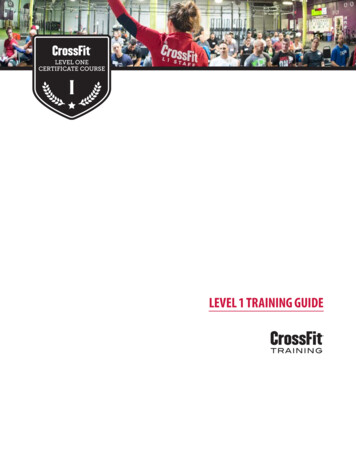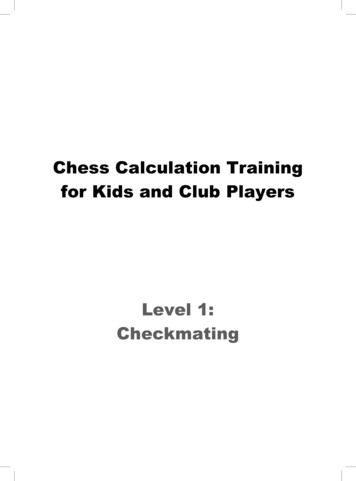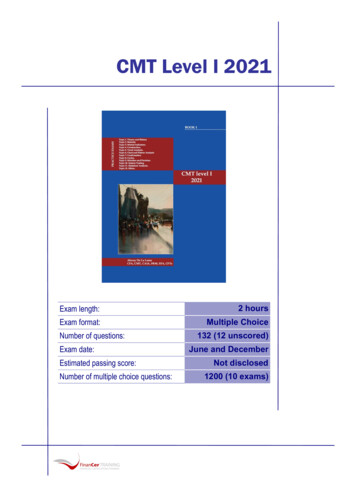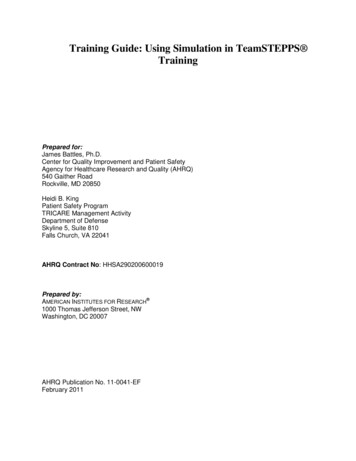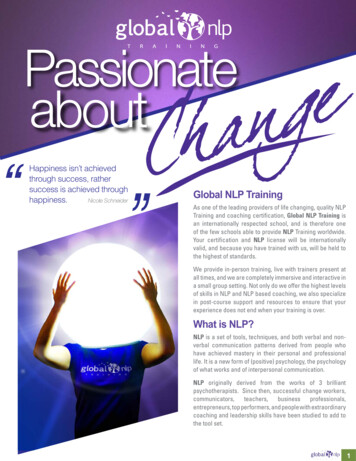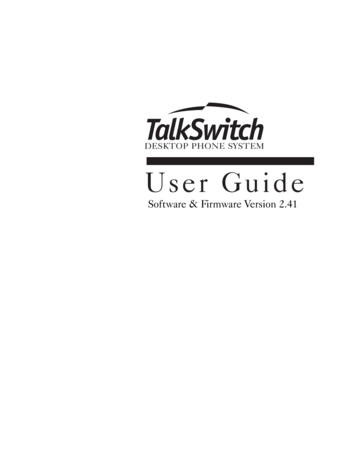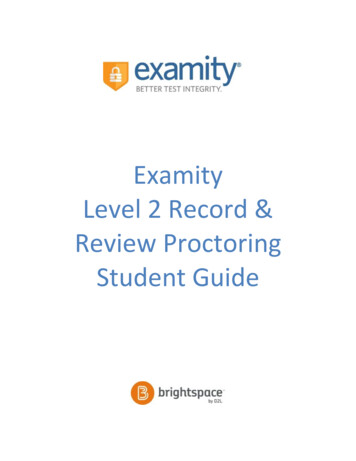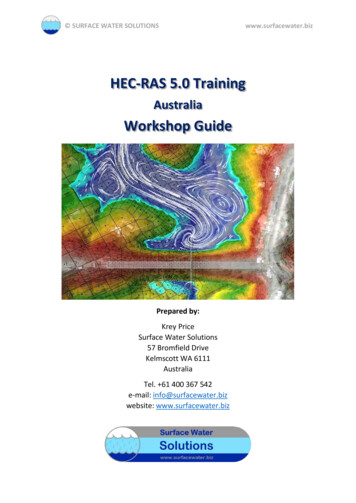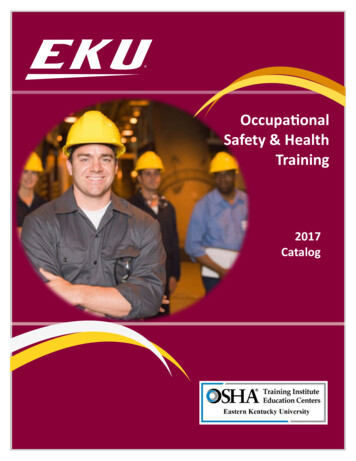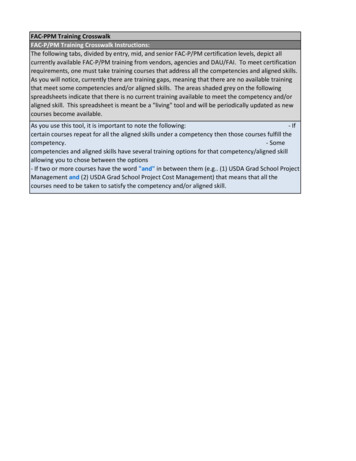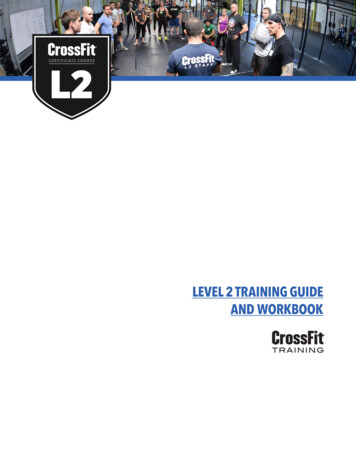
Transcription
LEVEL 2 TRAINING GUIDEAND WORKBOOK
Level 2 Training Guide and WorkbookTable of Contents TABLE OF CONTENTSCOURSE OVERVIEW. . . . . . . . . . . . . . . . . . . . . . . . . . . . . . . . . . . . . . . . . . . . . . . . 2Preparation For the Course. . . . . . . . . . . . . . . . . . . . . . . . . . . . . . . . . . . . 2Summary Sheet: Squats . . . . . . . . . . . . . . . . . . . . . . . . . . . . . . . . . . . . 3Summary Sheet: Presses . . . . . . . . . . . . . . . . . . . . . . . . . . . . . . . . . . . 4Summary Sheet: Deadlifts. . . . . . . . . . . . . . . . . . . . . . . . . . . . . . . . . . 6Course Goals . . . . . . . . . . . . . . . . . . . . . . . . . . . . . . . . . . . . . . . . . . . . . . . . . 8Learning Objectives. . . . . . . . . . . . . . . . . . . . . . . . . . . . . . . . . . . . . . . . . . . 8Schedule. . . . . . . . . . . . . . . . . . . . . . . . . . . . . . . . . . . . . . . . . . . . . . . . . . . . . 9Schedule With Translation. . . . . . . . . . . . . . . . . . . . . . . . . . . . . . . . . . . . 10Seminar Content Outline . . . . . . . . . . . . . . . . . . . . . . . . . . . . . . . . . . . . . 11DAY 1 . . . . . . . . . . . . . . . . . . . . . . . . . . . . . . . . . . . . . . . . . . . . . . . . . . . . . . . . . . . 13Learning Objectives . . . . . . . . . . . . . . . . . . . . . . . . . . . . . . . . . . . . . . . . . 13Foundations of Effective Training. . . . . . . . . . . . . . . . . . . . . . . . . . . . . . 14Practical Sessions. . . . . . . . . . . . . . . . . . . . . . . . . . . . . . . . . . . . . . . . . . . . 23Practical Exercise 1—Teaching and Seeing Movement Faults . . . . . 23Common Movement Themes for Functional Movements . . . . . . . . 25Practical Exercise 2—Seeing and Correcting Movement Faults . . . 33Heavy Days. . . . . . . . . . . . . . . . . . . . . . . . . . . . . . . . . . . . . . . . . . . . . . . . . . 35Teach Back 1—One-On-One Coaching . . . . . . . . . . . . . . . . . . . . . . . . . 38DAY 2 . . . . . . . . . . . . . . . . . . . . . . . . . . . . . . . . . . . . . . . . . . . . . . . . . . . . . . . . . . 40Learning Objectives. . . . . . . . . . . . . . . . . . . . . . . . . . . . . . . . . . . . . . . . . . 40Teach Back 2—Group Coaching. . . . . . . . . . . . . . . . . . . . . . . . . . . . . . . . 41Nutrition. . . . . . . . . . . . . . . . . . . . . . . . . . . . . . . . . . . . . . . . . . . . . . . . . . . . 43Program Design and Scaling. . . . . . . . . . . . . . . . . . . . . . . . . . . . . . . . . . . 50Example Warm-Ups to Address Weaknesses. . . . . . . . . . . . . . . . . . . . 61Programming Analysis Worksheet. . . . . . . . . . . . . . . . . . . . . . . . . . . . . 63Class Structure and Lesson Planning. . . . . . . . . . . . . . . . . . . . . . . . . . . 67Sample Coaching Evaluation Sheet . . . . . . . . . . . . . . . . . . . . . . . . . . . . 71Example Lesson Plans. . . . . . . . . . . . . . . . . . . . . . . . . . . . . . . . . . . . . . . . 72POST-COURSE . . . . . . . . . . . . . . . . . . . . . . . . . . . . . . . . . . . . . . . . . . . . . . . . . . . 80Where Do I Go From Here?. . . . . . . . . . . . . . . . . . . . . . . . . . . . . . . . . . . . 80Level 2 Training Guide and Workbook 1 of 80Copyright 2020 CrossFit, Inc. All Rights Reserved.V5.1-20200428KW
Level 2 Training Guide and WorkbookCourse OverviewPreparation For the Course, continuedPREPARATION FOR THE COURSEA large focus of the CrossFit Level 2 Certificate Course is allowing participants time to practice and work on theircoaching abilities in real time. The course includes sections called “Practical Exercises” and “Teach Backs,” wherestaff members lead participants in coaching drills and provide feedback on each person’s ability to coach others inCrossFit’s foundational movements.The best preparation for this is coaching experience. Ideally, participants will have at least 50 hours of coachingexperience prior to attending (approximately two classes a week for six months). This experience provides the bestpreparation for coaching in front of peers and receiving constructive feedback in real time. Participants are alsoencouraged to use resources in the CrossFit Level 1 Training Guide. Specifically, see “Appendix: Movement Guide,”which includes information on the nine foundational movements, and print copies for this course. More importantly,study and practice the material therein so you can be prepared to effectively teach your peers. The following pagesalso contain summary sheets for the nine foundational movements to further help you prepare.We also recommend that you take the Online Scaling Course, Online Lesson Planning Course, and Online Spotthe Flaw Course prior to attending this course. These online courses will help you hone your ability to scale for anyathlete, write effective lesson plans, and identify faults.Level 2 Training Guide and Workbook 2 of 80Copyright 2020 CrossFit, Inc. All Rights Reserved.
Level 2 Training Guide and WorkbookCourse OverviewSummary Sheet: Squats, continuedSUMMARY SHEET: SQUATSAIR SQUATTEACHINGSEEINGCORRECTINGSETUPPRIMARY POINTS OF PERFORMANCECOMMON FAULTSShoulder-width stanceFull extension at hips and kneesEXECUTIONHips descend back and downLumbar curve maintainedKnees in line with toesHips descend lower than kneesHeels downComplete at full hip and knee extensionLumbar curve maintainedWeight on heelsMove to a depth below parallelInitiate with the hips moving backKnees track in line with toesLoss of lumbar curve in flexionWeight in, or shifting to, the toesNot going low enoughInitiating with knees so weight is on the toesKnees caving inside the feetImmature squatFRONT SQUATTEACHINGSEEINGCORRECTINGSETUPPRIMARY POINTS OF PERFORMANCECOMMON FAULTSSAME AS AIR SQUAT, PLUS:SAME AS AIR SQUAT, PLUS:SAME AS AIR SQUAT, PLUS:Hands just outside the shouldersLoose, fingertip grip on the barElbows high (upper arms parallel tothe ground)Front-rack position maintainedBar stays close to the frontal planeImproper rack position (bar not in contactwith torso)Elbows dropping during the squat (bar movesaway from frontal plane)EXECUTIONSAME AS AIR SQUAT, PLUS:Maintain front-rack positionBar moves over the middle of the footOVERHEAD SQUATTEACHINGSEEINGCORRECTINGSETUPPRIMARY POINTS OF PERFORMANCECOMMON FAULTSSAME AS AIR SQUAT, PLUS:SAME AS AIR SQUAT, PLUS:SAME AS AIR SQUAT, PLUS:Wide grip on the bar (for a pass-through)Shoulders push up into the barArmpits face forwardOverhead position maintainedBar stays close to the frontal planeInactive overhead position (shouldersinactive, elbows bent)Bar moves forward of the frontal planeEXECUTIONSAME AS AIR SQUAT, PLUS:Maintain overhead positionBar moves over the middle of the footLevel 2 Training Guide and Workbook 3 of 80Copyright 2020 CrossFit, Inc. All Rights Reserved.
Level 2 Training Guide and WorkbookCourse OverviewSummary Sheet: Presses, continuedSUMMARY SHEET: PRESSESSHOULDER PRESSTEACHINGSEEINGCORRECTINGSETUPPRIMARY POINTS OF PERFORMANCECOMMON FAULTSHip-width stanceFull extension at hips and kneesElbows slightly in front of the barHands just outside the shouldersFull grip on the barLumbar curve maintainedHeels downBar stays close to the frontal planeMove through the full range of motionDemonstrate active shouldersOverextending the spine with the ribssticking outBar arcs out around the faceBar finishes forward of the frontal planeElbows are bent or shoulders are not activeat finishEXECUTIONChin moves backBar moves over the middle of the footSpine neutral and legs extendedHeels downShoulders push up into the barComplete at full arm extensionPUSH PRESSTEACHINGSEEINGCORRECTINGSETUPPRIMARY POINTS OF PERFORMANCECOMMON FAULTSSAME AS SHOULDER PRESSSAME AS SHOULDER PRESS, PLUS:SAME AS SHOULDER PRESS, PLUS:EXECUTION (DIP, DRIVE, PRESS)Bar rests on torsoTorso remains vertical as hips and knees flexin the dipHips and legs extend, then arms pressHeels remain down until the hips and kneesextendBar moves over the middle of the footComplete at full hip, knee, and arm extensionMove the torso in a straight lineExtend the hips before the arms pressCreate a fast turnaround from down to upForward inclination of the chestMuted hipArms press before the hip extendsPausing at the bottom of the dipPROGRESSION (WITH PVC)1. Dip and hold2. Dip-drive, slow3. Dip-drive, fast4. Push pressLevel 2 Training Guide and Workbook 4 of 80Copyright 2020 CrossFit, Inc. All Rights Reserved.
Level 2 Training Guide and WorkbookCourse OverviewSummary Sheet: Presses, continuedPUSH JERKTEACHINGSEEINGCORRECTINGSETUPPRIMARY POINTS OF PERFORMANCECOMMON FAULTSSAME AS SHOULDER PRESSSAME AS SHOULDER PRESS AND PUSH PRESS,SAME AS SHOULDER PRESS AND PUSH PRESS,EXECUTION (DIP, DRIVE, PRESS UNDER,PLUS:PLUS:STAND)Bar rests on torsoTorso remains vertical as hips and knees flexin the dipHips and knees extend rapidly, then armspress to drive under the barHeels stay down until the hips and kneesextendBar moves over the middle of the footReceive the bar in a partial overhead squatComplete at full hip, knee, and armextensionReach full hip extension in the driveReceive the bar with locked-out armsReceive the bar in a sound partial squatLack of full hip extension in the drivePoor active overhead position when receivingLanding too wideNot standing up with the weight beforere-racking itPROGRESSION(STEPS #1–3 NO PVC; STEP #4 WITH PVC)1. Jump and land with hands at sides2. Jump and land with hands at shoulders3. Jump and extend the arms after thehips open4. Push jerkLevel 2 Training Guide and Workbook 5 of 80Copyright 2020 CrossFit, Inc. All Rights Reserved.
Level 2 Training Guide and WorkbookCourse OverviewSummary Sheet: Deadlifts, continuedSUMMARY SHEET: ARY POINTS OF PERFORMANCECOMMON FAULTSHip- to shoulder-width stanceHands just outside hips with a full gripShoulders over or slightly in front of the barBar in contact with the shinsArms straightEyes on the horizonLumbar curve maintainedWeight on heelsBar stays close to the frontal plane and bodyTorso angle relatively constant during the initialpullDemonstrate active shouldersEXECUTIONLoss of lumbar curve in flexionWeight in, or shifting to, the toesShoulders behind the bar in the setupHips do not move back to initiate the descentBar loses contact with the legsHips rise without the chestShoulders rise without the hipsLumbar curve maintainedHips and shoulders rise at the same rate untilthe bar passes the kneesHips then extendBar moves over the middle of the footHeels downComplete at full hip and knee extensionSUMO DEADLIFT HIGH PULLTEACHINGSEEINGCORRECTINGSETUPPRIMARY POINTS OF PERFORMANCECOMMON FAULTSSAME AS THE DEADLIFT, PLUS:SAME AS THE DEADLIFT, PLUS:Slightly wider than shoulder-width stance;knees in line with toesHands inside the legs with a full gripShoulders over or slightly in front of the barBar in contact with the shinsArms straightEyes on the horizonEXECUTION (DEADLIFT, SHRUG, PULL)Lumbar curve maintainedHips and shoulders rise at the same rate untilthe bar passes the kneesHips then extend rapidlyHeels down until hips and legs extendShoulders shrug, then the arms pullElbows move high and outsideBar moves over the middle of the footComplete at full hip and knee extension withthe bar pulled under the chinHips extend before the arms pullHips extend rapidlyShoulders shrug or arms bend before thehips extendElbows pull low and insideMoving too slowly (i.e., segmenting themovement)Incorrect descent (hips flex before the armsextend)Shoulders roll forward during the pullPROGRESSION (WITH PVC)1.2.3.4.Sumo deadliftSumo deadlift-shrug, slowSumo deadlift-shrug, fastSumo deadlift high pullLevel 2 Training Guide and Workbook 6 of 80Copyright 2020 CrossFit, Inc. All Rights Reserved.
Level 2 Training Guide and WorkbookCourse OverviewSummary Sheet: Deadlifts, continuedMEDICINE-BALL CLEANTEACHINGSEEINGCORRECTINGSETUPPRIMARY POINTS OF PERFORMANCECOMMON FAULTSSAME AS THE DEADLIFT AND SUMO DEADLIFTSAME AS THE DEADLIFT AND SUMO DEADLIFTHIGH PULL, PLUS:HIGH PULL, PLUS:Shoulder-width stanceBall between the feet with palms on the ballKnees in line with toesShoulders over ballArms straightEyes on the horizonEXECUTION (DEADLIFT, SHRUG,PULL UNDER, STAND)Lumbar curve maintainedHips extend rapidlyShoulders then shrugHeels down until the hips and knees extendArms then pull under to the bottom of thesquatBall stays close to the bodyComplete at full hip and knee extension withthe ball at the rack positionReach full hip extension in the driveReceive the ball in a sound front squatLack of full hip extension in the driveCurling the ballCollapsing in the receiving positionReceiving too high (i.e., power clean thensquat)No pull-under (e.g., tossing the ball up)Not standing up before lowering the weightPROGRESSION (WITH MEDICINE BALL)1.2.3.4.5.DeadliftDeadlift-shrug, fastFront squatPull-underMedicine-ball cleanLevel 2 Training Guide and Workbook 7 of 80Copyright 2020 CrossFit, Inc. All Rights Reserved.
Level 2 Training Guide and WorkbookCourse OverviewCourse Goals, continuedCOURSE GOALSThe Level 2 Course is intended to improve participants’ understanding and implement
LeveL 2 Training guide and Workbook Course overvieW Copyright 2020 CrossFit, Inc. All Rights Reserved. Level 2 Training Guide and Workbook 8 of 80 COURSE GOALS The Level 2 Course is intended to improve participants’ understanding and implementation of: 1. Essential mechanics of functional movement. 2. Fault identification and correction. 3. Essential qualities of an effective trainer.File Size: 1MBPage Count: 83


